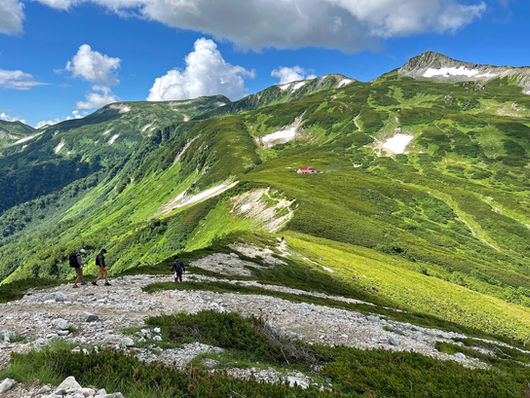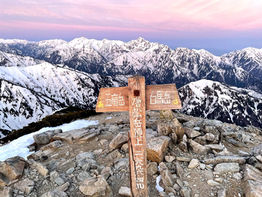
NAGANO ADVENTURES
Guided & Self-Guided Hiking, Trail Running & Fastpacking Tours in Japan
Specializing in the Shionomichi (Salt Road) & Japanese Alps

THE JAPANESE ALPS
Japan's Ultimate Alpine Playground
OVERVIEW
The Japanese Alps (Northern, Central, and Southern) are incredibly scenic and dynamic mountain ranges that reach heights of over 3,000m and feature a dazzling number and variety of easily accessed trails that are still almost completely overlooked by international tourists. They provide the perfect setting to immerse yourself in Japan's pristine natural landscapes while offering a unique perspective into Japanese culture and plentiful opportunities to connect with local hikers. Whether you're looking to add a spur-of-the-moment day hike into your itinerary to spice up your trip with fresh mountain air and panoramic views, or aiming for a serious 10-day hut-to-hut traverse across the roof of Japan, we can put together the perfect plan. If mountain running is more your thing, the often steep and rocky trails here in the Alps are a fantastic place to test your fitness and technical prowess. The sky is the limit... and the setting for your Japanese alpine adventure.

PHOTO GALLERY
INFORMATION
Collective Name: The Japanese Alps (Sometimes written as the Japan Alps)
Ranges: The Northern Alps, Central Alps & Southern Alps (Called the Kita Alps, Chuo Alps & Minami Alps in Japanese)
Alternative Monikers: Hida Mountains, Kiso Mountains & Akaishi Mountains, respectively

The Central Alps are located wholly inside Nagano Prefecture, while the Northern and Southern Alps straddle the prefecture's northwestern and southeastern borders. Each range has distinctive regions and uniquely compelling reasons to visit.
The Northern Alps
Tateyama Range - The majestic Tateyama Range is a great introduction to the Alps, because of both its overwhelming beauty and ease of access. The Tateyama Kurobe Alpine Route famously whisks hikers and sightseers up to a beautiful volcanic plateau at 2,450m, using a variety of transportation methods including bus, train, cable car, trolley, and ropeway. The journey itself is incredibly scenic, and the finishing point, Murodo, can be used as a staging ground for climbs of the rugged pyramidal peak of Tsurugi and the holy summit of Tateyama, as well as the starting point for one of Japan's premier multi-day traverses.
Ushiro-Tateyama Range - The Ushiro-Tateyama Range largely forms the border between Niigata and Toyama Prefectures to the north and west, and Nagano to the south and east. The 1998 Nagano Winter Olympics were held in part here at the famous ski resorts of the Hakuba Valley, which hug the range's eastern slopes, and visitors from around the world flock here each winter to ski Japan's pristine powder. These are our local mountains, and are quite popular with Japanese hikers during the "green season," yet remain relatively undiscovered overseas. The views are some of the best in Japan, with areas that remain snow-covered year-round, vast fields of wildflowers, intense greenery, and so much more.
The Central Alps
The Central Alps are the most compact range of the three, but still boast 54 named peaks that reach the same lofty heights as their counterparts to the north and south, and the views and challenges they offer visitors are every bit as rewarding. Glacially carved cirques, rocky peaks, and 360-degree views are just some of the highlights of this awesome area.
The Southern Alps
The Southern Alps, particularly the southern end, are where you'll find some of the most rugged and remote trails in Japan. This towering range is home to Japan's second tallest mountain, Mt. Kita (3,193m), and nearly half of Japan's 3,000m peaks. Yet, the Southern Alps have a different character than the Northern and Central Alps, in part due to the lower treeline. As a result, relatively more time here is spent in the forest, though the southerly location means that when you are on the ridge, you're often greeted with fantastic, up-close views of Mt. Fuji. This is a great option for those who want to get as close to nature as possible.
THE JAPANESE ALPS x NAGANO ADVENTURES
QUALIFIED
I am a licensed English-speaking mountain guide for Azumino City as well as a professional-level Wilderness First Responder. I've been exploring the Japanese Alps for more than two decades, and have summited nearly every major peak multiple times. In fact, I am the only non-Japanese person to have climbed all of Japan's 100 Tallest Mountains.
KNOWLEDGEABLE
I'm intimately familiar with the best trails, nicest huts, most convenient campgrounds, must-see scenic spots, cleanest water sources, local weather patterns, escape routes, transportation to and from the trailheads, wildlife, edible plants, necessary gear, and so much more.
LOCAL
I live at the base of the Northern Alps and spend nearly all of my free time hiking, fastpacking, and running above the treeline. In addition to guiding, I also work occasionally with the local mountain guide association on trail maintenance, wildlife surveys, portering jobs, and more in order to form deeper connections and give back to the community.
FASTPACKING / RUNNING
I am one of very few guides, if not the only one, offering fastpacking and running tours in the Japanese Alps - in any language. I'm not the fastest runner, but I am adept at technical terrain and have an engine that can go all day long, for days on need. If you want to run the Alps, look no further.





THE JAPANESE ALPS BY SEASON
At elevations that reach near to or exceed 3,000 meters (9,843 feet), the Japanese Alps experience extreme seasonal shifts that follow a strikingly different timeline than the rest of the country. There can be a significant difference in conditions between ranges or from one end of a particular range to the other, even at similar altitudes. As a general rule, those hoping to do more traditional summer-style hiking without the need for extra gear or experience on snow, the Alps can usually be considered snow-free from mid-July to mid-October, though this can vary from year to year depending on the winter's snowpack, spring temperatures, etc...

Seasonal Highlights
Late April to Early May - Snow still dominates the landscape, but mountain huts slowly re-open and large numbers of hikers begin to return to certain areas of the Alps during the national Golden Week holiday period. While the big cities near sea level are heating up, full-on winter conditions are a real possibility in the mountains, and full winter kit including crampons, ice axe, helmet, and goggles is the standard for this season.
Mid to Late July - By now the rainy season is drawing to a close, and the extended wet weather of the past month or so has melted the majority of the snow away from the trails. Most huts are open, days are long, buses are running to the trailheads, and the peak summer climbing season begins in earnest. Vibrant summer greenery has returned to the slopes and ridgelines, contrasted spectacularly with fields of wildflowers and lingering snowfields. This is a great time to be in the Alps.
August to September - The elevated ridgelines of the Alps provide an excellent escape from the oppressive heat and humidity that smothers the country in mid to late summer, with temperatures typically 12 to 15 degrees Celcius cooler than the cities below. This can be a good time to visit in general, but the Obon holiday period in mid-August can draw large crowds to the trail, and make it hard to book mountain huts during that time. Furthermore, typhoon season ramps up in August and the risk remains high through September. It may be a good idea to keep your dates flexible, or add an extra day or two to your itinerary as backup days in case of foul weather. Morning and overnight temperatures do begin to drop around late August, so you'll need to have slightly warmer 3-season gear if camping then. The timing of the fall colors depends on the range and elevation, but they can be enjoyed up high as early as mid-September.
October - Snow can fall at any time on the highest peaks in October, but typically doesn't begin to accumulate in earnest until the second half of the month. A lot of huts begin to close in September, less people are on the trails, and temperatures can drop well below freezing after dark, so you'll need to choose your destination carefully and be more experienced and better prepared when planning a trip at this time.
MAIN ACTIVITIES

HIKING

FASTPACKING

(MOUNTAIN)
RUNNING
LOCATION & ACCESS


The Japanese Alps are located in Japan's Chubu Region, lying largely within Nagano, but also occupying portions of Niigata, Toyama, Gifu, Yamanashi, and Shizuoka Prefectures. The particular access point you'll use will depend on the range you plan to visit, and more specifically on the particular mountain or route you hike within that range. However, in general, Matsumoto is an ideal jumping off point for many parts of the Northern Alps, while the city of Komagane is convenient for venturing into both the Central and Southern Alps. These gateway cities are unfortunately not served by shinkansen (bullet trains), but Matsumoto can still be reached within 3 hours or less, and Komagane is reachable in under 5 hours by train and/or highway bus from major cities across Japan.
To/From MATSUMOTO
Tokyo
2 hours 30 minutes
(Azusa Ltd. Express)
Osaka
3 hours
(Tokaido Shinkansen &
Shinano Ltd. Express)
Nagoya
2 hours
(Shinano Ltd. Express)
To/From KOMAGANE
Shinjuku (Tokyo)
3 hours 20 minutes
(Azusa Ltd. Express &
JR Iida Line)
Osaka
4 hours 40 minutes
(Highway Bus)
Nagoya
2 hours 30 minutes
(Highway Bus)
























